In the 1870s, newspapers began describing with great interest Chinese New Year celebrations in New York’s fledgling Chinatown. Even before Chinese Exclusion made entry and reentry into the US difficult, working Chinese migrants who could not afford regular steamship passage back to China gathered together for a banquet and a game of mahjong in the Chinese Temple on 12 Baxter Street, which was “brightly illuminated” and “decorated with colored paper lanterns, flowers, and wax candles” for this occasion. Early celebrations were described as quiet affairs, unlike in later decades when a New York Tribune report in 1894 proclaimed that “all kinds of oriental noises and jollifications” could be heard on Mott, Pell, Doyers and adjoining streets and “gung hei fat choi” salutations “became so common that even the street urchins took up the cry.” Music from home could be heard coming from the temple and Chinese, dressed in their New Year’s new clothing and carrying lucky red envelopes, feasted and visited with family and friends. Later still, in the 1920s and ‘30s, celebrations grew more elaborate and public to incorporate a street parade, with loud fireworks, gongs, and lion dancers that were more in keeping with tradition back in China. The selected photographs from MOCA’s archive document these public street celebrations of Chinese New Year in Chinatown through the decades beginning with the 1930s. Many of the shots capture lion dancers trained in local martial arts schools spreading good luck and prosperity to Chinatown’s businesses.
Read阅读Read阅读Read阅读Read阅读Read阅读Read阅读Read阅读Read阅读Read阅读Read阅读Read阅读Read阅读Read阅读Read阅读Read阅读Read阅读Read阅读Read阅读Read阅读Read阅读Read阅读Read阅读Read阅读Read阅读Read阅读Read阅读Read阅读Read阅读Read阅读Read阅读Read阅读Read阅读Read阅读Read阅读Read阅读Read阅读Read阅读Read阅读Read阅读Read阅读Read阅读Read阅读Read阅读Read阅读Read阅读Read阅读Read阅读Read阅读Read阅读Read阅读Read阅读Read阅读Read阅读Read阅读Read阅读Read阅读Read阅读Read阅读Read阅读Read阅读Read阅读Read阅读Read阅读Read阅读
Chinese New Years Past
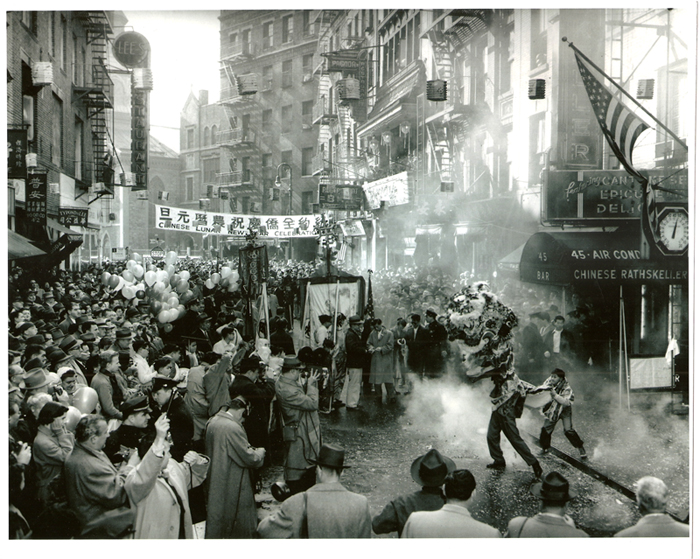
2015.043.032 Crowds flood the streets to see a lion dance outside the Chinese Rathskeller Restaurant on 45 Mott Street during a Chinese Lunar New Year Celebration. Other shops on the street include Pagoda Restaurant, Lee’s Restaurant, Typond & Lee, Po On Co. It is a grand celebration with balloons, confetti, firecrackers, and a parade with dancers and portable shrines, undated. Courtesy of Eric Y. Ng, Museum of Chinese in America (MOCA) Collection. 2015.043.032 在纽约华人农历新年庆祝活动期间,人群涌入街道,观看位于勿街 45 号的中国 Rathskeller 餐厅外的舞狮。街上的其他商店包括 Pagoda 餐厅、Lee’s 餐厅、Typond & Lee、Po On Co.。这是一个盛大的庆祝活动,有气球、五彩纸屑、鞭炮,还有舞者和便携式神龛的游行,日期不详。由伍锐贤提供,美国华人博物馆 (MOCA) 馆藏。
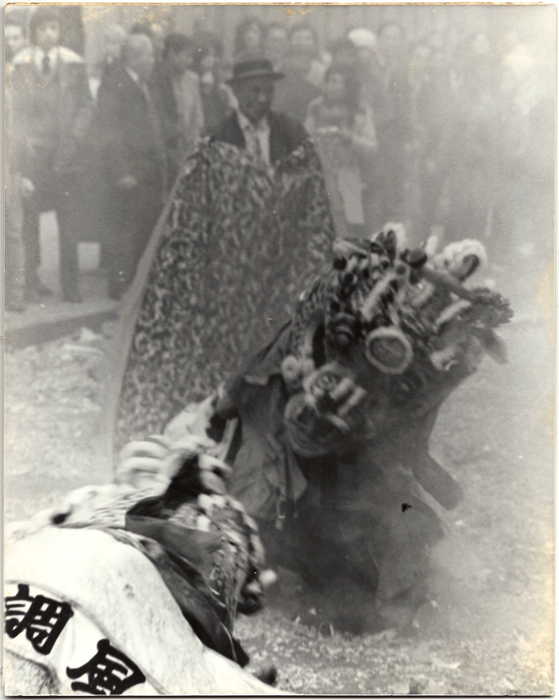
2010.020.013 Two lion dancers performing in a street littered with fireworks, undated. Photograph taken by Wing Nen Lem. Courtesy of Betty Lem, Museum of Chinese in America (MOCA) Collection. 由Betty Lem提供,美国华人博物馆 (MOCA) 馆藏。
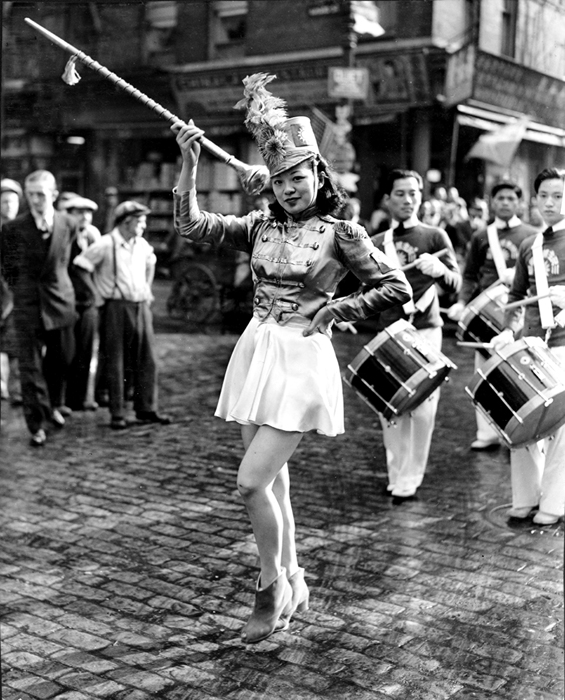
2009.023.002 A woman with a Taiwanese flag on her hat is holding a baton in a Chinese New Year parade. She is being followed by a marching band, 1934-1935. Courtesy of Marylin Chou, Museum of Chinese in America (MOCA) Collection. 2009.023.002 一个帽子上挂着台湾国旗的女人在中国新年游行中拿着一根指挥棒。 1934 年至 1935 年,一支军乐队跟随她。由Marylin Chou 提供,美国华人博物馆 (MOCA) 馆藏。
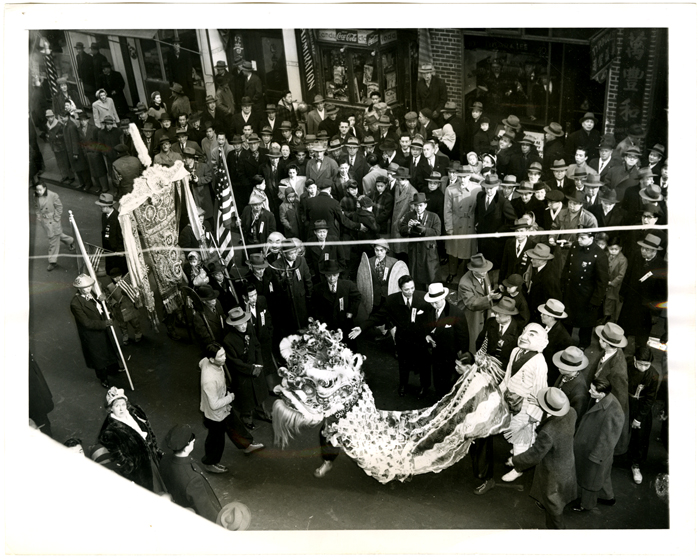
2015.043.041 Chinese Lunar New Year Celebration, Mott Street, Chinatown, January 22, 1947. Photograph taken by the Associated Press. Courtesy of Eric Y. Ng, Museum of Chinese in America (MOCA) Collection. 2015.043.041 中国农历新年庆祝活动,唐人街勿街,1947 年 1 月 22 日。照片由美联社拍摄,伍锐贤提供,美国华人博物馆 (MOCA) 馆藏。
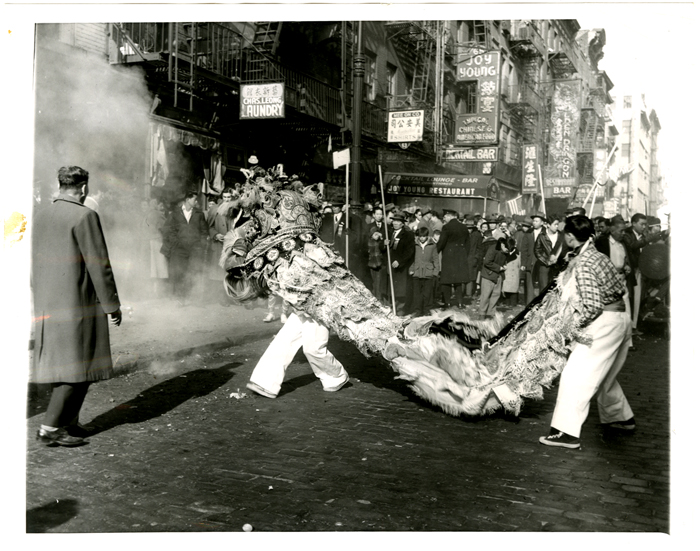
2015.043.042 A lion dances in celebration of the Year of the Lamb on Mott Street. Smoke from firecrackers fill the street as a crowd enjoys the festivities. A line of shops on the street include Chas Leong Laundry, Mee On Co. Shirts, Joy Young Restaurant & Bar and Golden Dragon Restaurant & Bar, January 24, 1955. Photograph taken by the Associated Press. Courtesy of Eric Y. Ng, Museum of Chinese in America (MOCA) Collection. 2015.043.042 勿舞狮庆祝羊年。当人群享受庆祝活动时,鞭炮的烟雾弥漫在街道上。 1955 年 1 月 24 日,街上的一系列商店包括 Chas Leong Laundry、Mee On Co. Shirts、Joy Young 餐厅和酒吧和金龙餐厅酒吧。照片由美联社拍摄,伍锐贤提供,美国华人博物馆 (MOCA) 馆藏。
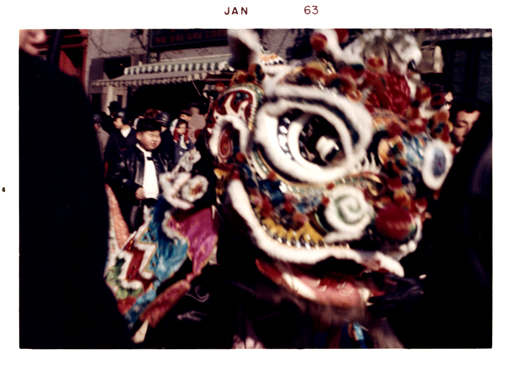
2011.004.060 A lion dancer during a Chinese New Year Parade in New York City's Chinatown, January 1963. Courtesy of Pui Leung, Museum of Chinese in America (MOCA) Collection. 2011.004.060 1963 年 1 月在纽约唐人街举行的中国新年游行中的舞狮人。由Pui Leung提供,美国华人博物馆 (MOCA) 馆藏。
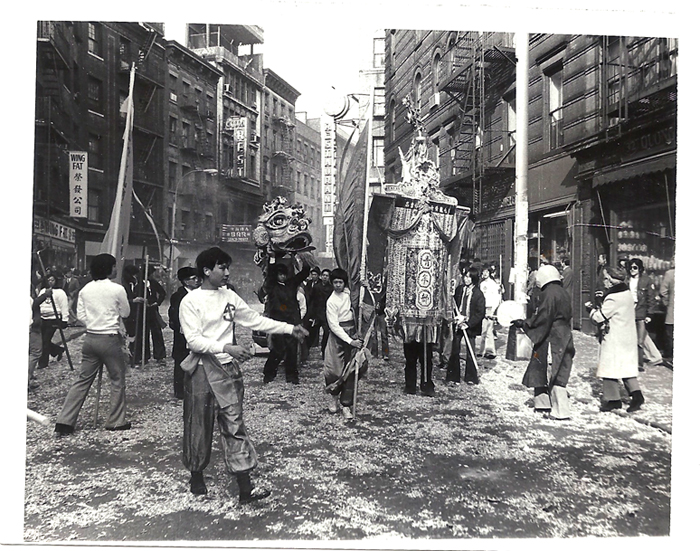
2014.029.331 People carry what appears to be an altar; behind them are lion dancers. Seems to be Mott Street, January 31, 1976. Photograph taken by Emile Bocian, Courtesy of Emile Bocian, Museum of Chinese in America (MOCA) Collection. 2014.029.331 人们抬着看似祭坛的东西;他们身后是舞狮者。似乎是在勿街,1976 年 1 月 31 日。照片由 Emile Bocian 拍摄,由 Emile Bocian 提供,美国华人博物馆 (MOCA) 馆藏。
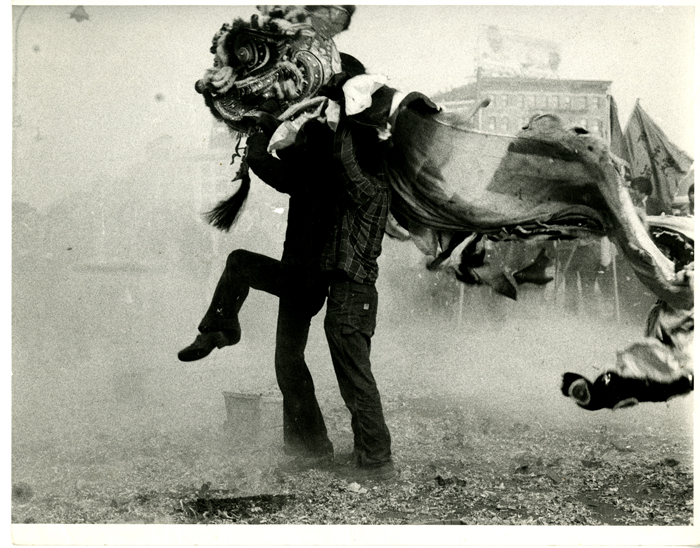
2013.018.037 Two men doing the lion dance. The entire background is obscured by firecracker smoke and the ground is littered with paper. This was most likely taken in New York's Chinatown during a Lunar New Year celebration, ca. 1971-1987. Museum of Chinese in America (MOCA) Basement Workshop Collection. 2013.018.037 两人舞狮。整个背景都被鞭炮的烟雾遮住了,地上散落着纸。这很可能是在农历新年庆祝活动期间在纽约唐人街拍摄的。 大约1971-1987 年。美国华人博物馆(MOCA)地下室工作坊馆藏。
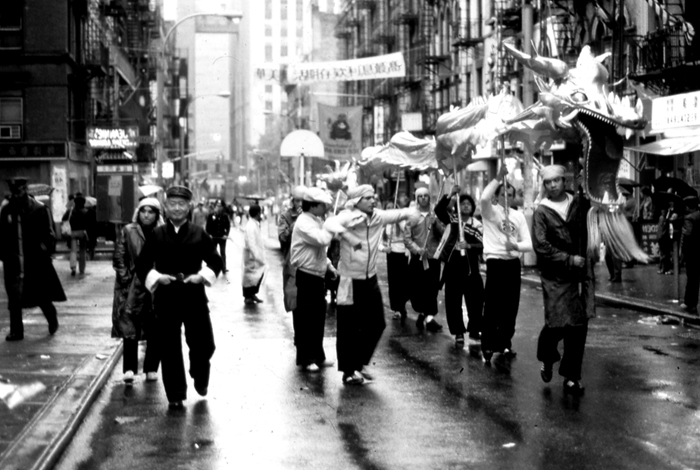
2016.025.008 Shifu Woo Chia Meng and members of the New York Honan Shaolin Association Golden Dragon Team marching down Bayard Street for a Chinese New Year celebration, 1979. Courtesy of Honan Shaolin Association, Golden Dragon Team, Museum of Chinese in America. 2016.025.008 Woo Chia Meng师父和纽约河南少林协会金龙队成员在摆也街游行庆祝中国农历新年。由河南少林协会提供,美国华人博物馆(MOCA)馆藏。
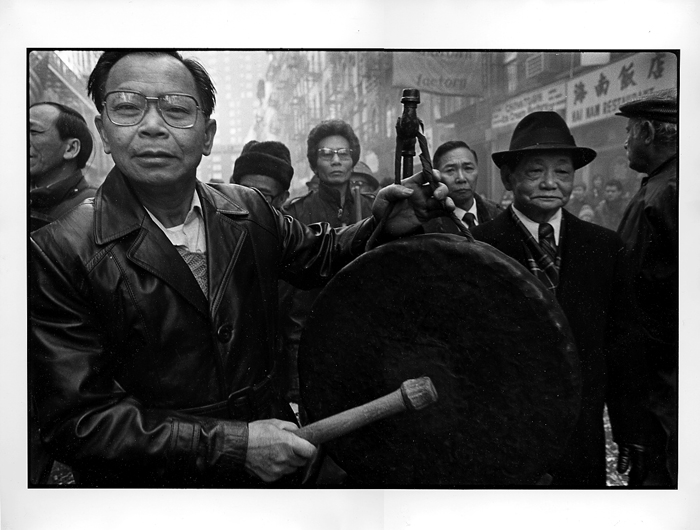
2004.045.055 A man banging on a gong during a Chinese New Year celebration, 1984. Photograph taken by Robert Glick, Museum of Chinese in America (MOCA) Collection. 2004.045.055 1984 年中国新年庆祝活动中一名男子敲锣。照片由Robert Glick拍摄,美国华人博物馆 (MOCA) 馆藏。
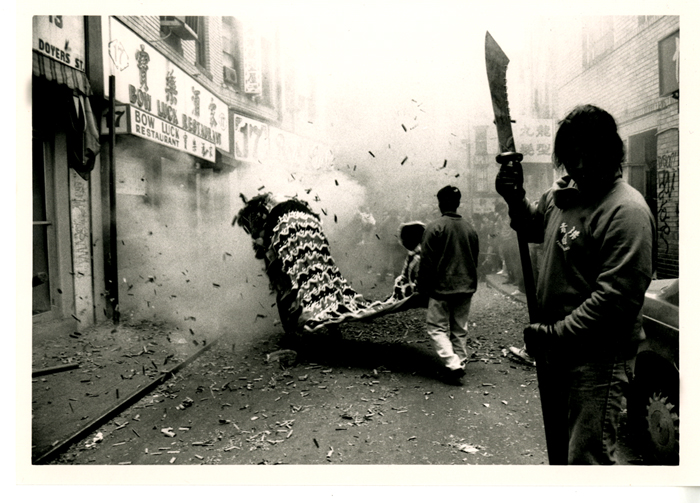
2015.010.030 A lion dancer and a man holding a holding a guandao during a Chinese New Year celebration. The man with the guandao is wearing a sweatshirt from the freemasons. They are on Doyer Street outside of the Bow Luck Restaurant, 1992. Photograph taken by Kitty Katz. Courtesy of Kitty Katz, Museum of Chinese in America (MOCA) Collection. 2015.010.030 在农历新年庆祝活动中,一名舞狮者和一名手持关刀的男子。拿着关刀的男人穿着一件共济会的运动衫。他们位于 Bow Luck 餐厅外的宰也街,1992 年。照片由 Kitty Katz 拍摄,Kitty Katz 提供,美国华人博物馆 (MOCA) 馆藏。